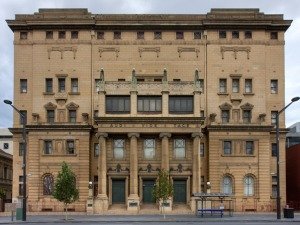By Sarah-Anne Martin
This semester I have had the privilege of working on a Directed Study project with Curator Murray Olsson and the volunteers at the Adelaide Masonic Centre Museum, which can be found within the Freemasons Hall, 254 North Terrace, Adelaide. I have been volunteering on and off at the museum for well over a year now and have had some fantastic opportunities presented to me as a result. From the outset one might be forgiven for feeling somewhat intimidated by the Freemasons Hall, after all it is a very large building which belongs to what is considered to be a very exclusive and secretive group: The Freemasons. However, if you ever get the chance to take a tour of the Freemasons Hall you will see that this feeling is misplaced, as the building alone is incredible but the people are also friendly and happy to answer any questions you have about their organization.

Figure 1. Adelaide Freemasons Hall (Source: Freemasons South Australia and Northern Territory)
The museum, found on the ground floor of Freemasons Hall, is packed to the brim with memorabilia and artefacts from the practice of Freemasonry in South Australia and the Northern Territory. Up until recently the museum did not have an official program for cataloguing its collections, apart from excel spreadsheets, but after receiving a grant from History SA the museum has begun to embark on the colossal task of setting up its catalogue. This is where I come in. Having been the person to submit the grant and begin the process I have been set the task of cataloguing a collection under the direction of the curator Murray Olsson, and using the things I learn as a basis for future cataloging projects. This is no small feat and is a task that has been a tremendous learning opportunity for me.
My Directed Study project focuses on cataloguing the Museum’s collection of Past Masters Jewels, which consists of over 300 individual objects. The Past Masters Jewels collection provides a record of the men who have served the organization as a Master in one of the many lodges in South Australia. Each Past Masters Jewel has a unique inscription stating the name of the recipient and the date of service, providing a very clear historical record of each jewel. In addition, the collection holds jewels from as early as the late 1800s, many of which are gold, making the collection highly significant and a priority for conservation, protection and maintenance. It is certainly a privilege to be working with such an amazing collection and to gain further insight into a very historically significant organization.

Figure 2. A small part of the Past Masters Jewel Collection at Adelaide Masonic Centre Museum.

